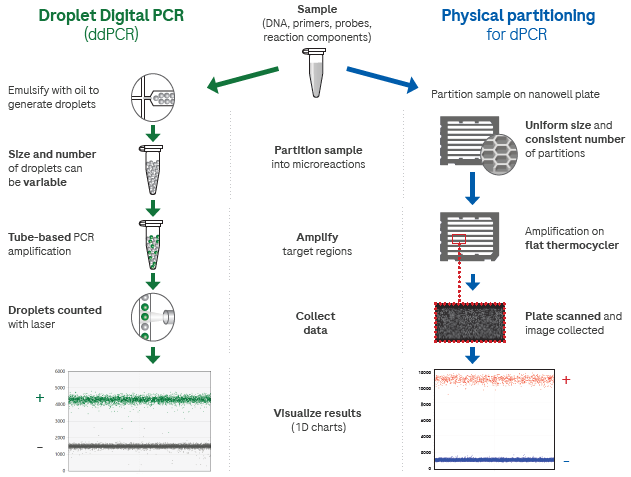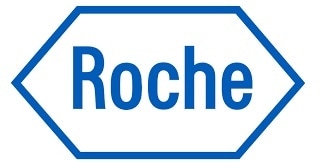Digital PCR is based on the partitioning of a PCR reaction mixture into microreactions, which is then followed by end-point amplification. Partitions are examined to check if they contain target sequences (positive) or not (negative). Poisson calculations are then used to quantify the absolute target content in the inputted sample.

Image Credit: Roche Sequencing and Life Science
The first dPCR technologies created tiny droplets of special oils to contain the microreactions. However, recent innovations, including the Roche Digital LightCycler® dPCR System, use a physical partition of nanowell plates instead. This method provides several advantages over the earliest droplet-based dPCR methods.
Nanowell plates yield consistent numbers of equally sized partitions

Figure 1. A comparison between sample partitioning workflows for droplet digital PCR (ddPCR) and nanowell-based physical partitioning. The Roche Digital LightCycler® dPCR instrument uses nanowell plates, and each run yields high numbers of valid partitions (see Figure 2). Image Credit: Roche Sequencing and Life Science
Digital LightCycler® dPCR System consistently yields high numbers of valid partitions

Figure 2. A comparison of the number of valid partitions obtained with three different partitioning methods. Each column shows partitions obtained for several sample types (cfDNA, FFPE DNA, RNA), and each black dot represents the number of valid partitions from one sample. Partitioning was carried out on the BioRad QX200 (n=51) and on the Roche Digital LightCycler® dPCR System using two different plate configurations: High Sensitivity plate (n=95) and High Resolution plate (n=55). Image Credit: Roche Sequencing and Life Science
Partitions are created on the partitioning engine instrument

Figure 3. Illustration of how the partitioning fluid separates the sample on the nanowell plate. (A) The dPCR reaction mixture (template/sample and PCR components) is manually loaded into the inlet port of each lane; the dPCR reaction mixture is shown in light blue. (B) The sample then flows across the plate via passive filling, traveling across about one-third of the lane. (C) The plate is placed on the Partitioning Engine, and partitioning fluid (dark blue fluid) is injected into the inlet ports. (D) As the partitioning fluid moves across the lanes, the sample is pushed upwards and into the partitions (sealed partitions shown in gold). (E) At the end of the process, the partitioning fluid has traveled down the length of each lane and sealed each partition from the bottom, isolating it within the nanowell plate. Image Credit: Roche Sequencing and Life Science
The Digital LightCycler® dPCR System offers three unique nanowell configurations

Image Credit: Roche Sequencing and Life Science
About Roche Sequencing and Life Science
 Roche Sequencing & Life Science is part of Roche Diagnostics, which, along with Roche Pharmaceuticals, plays an important role in modern healthcare. Roche Diagnostics’ broad range of innovative diagnostic tests and systems play a pivotal role in the groundbreaking area of integrated healthcare solutions and cover the early detection, targeted screening, evaluation and monitoring of disease. Roche Diagnostics is active in all market segments, from scientific research and clinical laboratory systems to patient self-monitoring.
Roche Sequencing & Life Science is part of Roche Diagnostics, which, along with Roche Pharmaceuticals, plays an important role in modern healthcare. Roche Diagnostics’ broad range of innovative diagnostic tests and systems play a pivotal role in the groundbreaking area of integrated healthcare solutions and cover the early detection, targeted screening, evaluation and monitoring of disease. Roche Diagnostics is active in all market segments, from scientific research and clinical laboratory systems to patient self-monitoring.
Sponsored Content Policy: News-Medical.net publishes articles and related content that may be derived from sources where we have existing commercial relationships, provided such content adds value to the core editorial ethos of News-Medical.Net which is to educate and inform site visitors interested in medical research, science, medical devices and treatments.